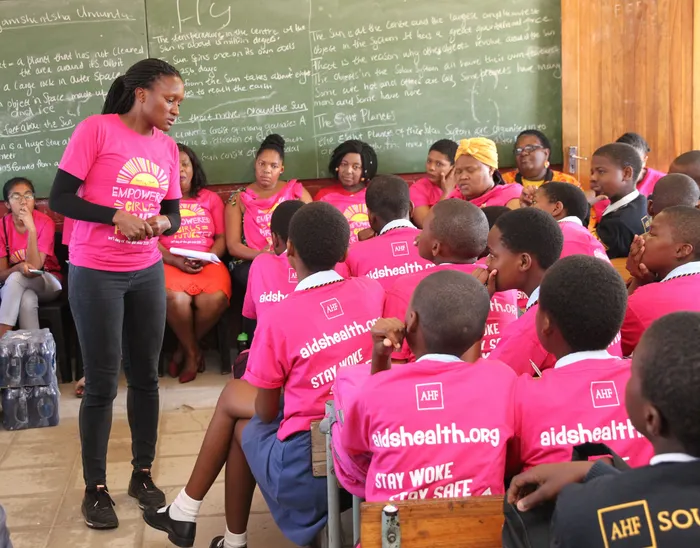‘Education is key to protect Africans from HIV’

Picture: Doctor Ngcobo/African News Agency (ANA)/October 8, 2019 – Dr Azande August from Ithembalethu clinic interacts with pupils at uMlazi on the 8th annual International Day of the Girl Child. AIDS Healthcare Foundation (AHF) with the Department of Basic Education hosts a #StyleUp event around the theme 'Empowered Girls into a brighter future’ in uMlazi, KwaZulu-Natal, South Africa.
Picture: Brendan Magaar/African News Agency (ANA)/April 14, 2023 – Stellenbosch University's Faculty of Medicine and Health Sciences launches brand new Biomedical Research Institute in Western Cape, South Africa. The key to preventing the growth of HIV cases in Africa is to educate people who are unaware of the dangers posed by cultural practices, such as female genital mutilation and child marriage, so that people can protect themselves and their communities from the virus’s spread, Kenyan expert says.
By Maxim Grishenkin
On May 21, World Remembrance Day of AIDS Victims was commemorated, with the day set up to bring awareness to the problems of AIDS patients and people living with HIV.
The key to preventing the growth of HIV cases in Africa is to educate people who are unaware of the dangers posed by cultural practices, such as female genital mutilation and child marriage, so that people can protect themselves and their communities from the virus’s spread, Dr Anthony Ajayi, an associate research scientist at the African Population and Health Research Centre, Kenya, told Sputnik Africa.
Sputnik sat down with the expert to discuss the HIV epidemic in Africa and the response to it, since, according to the WHO, it accounts for two thirds of the world’s AIDS patients.
“It’s important to continue to educate people. Education is important. When people are educated, and they are aware of some of these dangers of some cultural beliefs and practices, perhaps they are able to protect themselves,” Ajayi said.

Some cultural practices in Africa not only contribute to HIV/AIDS, but also threaten the lives of Africans, Ajayi said. Such life-threatening traditions include female genital mutilation and child marriage, which are common in Africa.
“We have traditional circumcisers that would perform this mutilation of the female genitalia. Often, they use unsterilised, sharp objects, which can further spread HIV ... practices like child marriage, where young girls are married off to older men, also puts them at risk of contracting HIV,” Ajayi said.
The expert also warned about the danger of resorting to traditional healers, who supposedly know how to treat HIV, even though their methods are scientifically unfounded.
“So people then don’t use their medications in hope of seeking healing in churches or even among traditional healers. And of course, that puts their life at risk because when they do not use their medication, it reduces progress and some even die as a result,” Ajayi said.
According to the expert, another option for reducing the spread of HIV on the continent is the substitution of these rites with alternative rituals that help people preserve their culture, as well as “prevent risky practices”.
In this context, as noted by Ajayi, interaction with religious leaders and communities “in dispelling some of these cultural beliefs” must be carried out to address the problem.
“If you work with the traditional leaders, the community leaders, let them understand some of the risk elements in their practices, perhaps we can begin to see some progress,” the expert stressed.
The Kenyan scholar testified about the effectiveness of prevention programmes in reducing the spread of AIDS in Africa, which include community-based HIV programmes, social protection programmes, as well as universal and couple testing and treatment.
According to the expert, the emergence of biomedical advances in HIV treatment plays a major role, which is one of the reasons for the continent’s noticeable progress in the battle against HIV, especially compared to the situation in the 1980s.
“There has been tremendous progress, since the 80s. New HIV infection has reduced significantly. In fact, the progress in sub-Saharan Africa in terms of new infection reduction is quite substantial,” Ajayi said. “So, from the latest data, there’s been around 32 percent decline since 2010 as well.”
However, the situation is complicated by the fact that this decrease could be stalled due to cuts in funding for anti-HIV programmes in Africa. The expert attributes this to the consequences of the Covid-19 pandemic and high inflation.
“What the data shows is that although there has been lots of progress, progress appears to be stalling now due to reduction in funding to programmes that work because of some of the challenges that we witness, the high inflation and the Covid pandemic,” Ajayi warned, adding that African countries are unable to replace those funds.
The expert cited a UNAIDS report on the global HIV response, saying that development assistance for HIV from bilateral donors other than the US has plummeted by 57 percent. He believes that domestic investments “are not replacing those losses”.
“That’s a significant change in the response to HIV,” Ajayi said.
Moreover, the professor shared some statistics on HIV spread in Africa. According to the data, HIV prevalence in sub-Saharan Africa is around 3.2 percent, reaching a maximum in eSwatini (27.9 percent) and a minimum in Niger (0.2 percent). The countries most affected by the epidemic are in Southern Africa, while West African countries have the lowest HIV prevalence, and the remaining states are in the middle range, the statistics provided by Ajayi revealed.
This article was first published in Sputnik